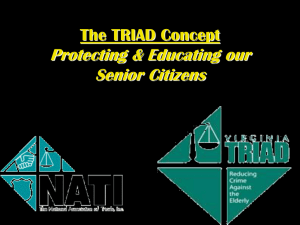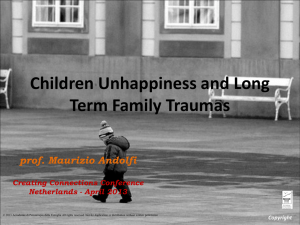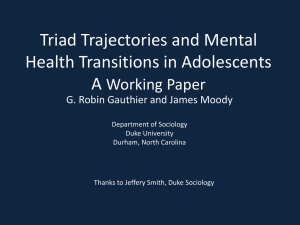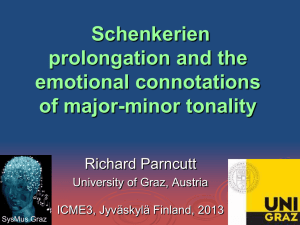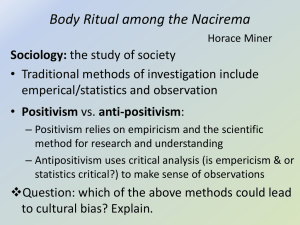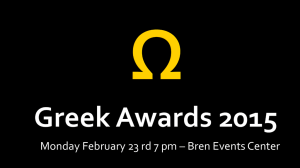Triads: social, political or religious group
advertisement
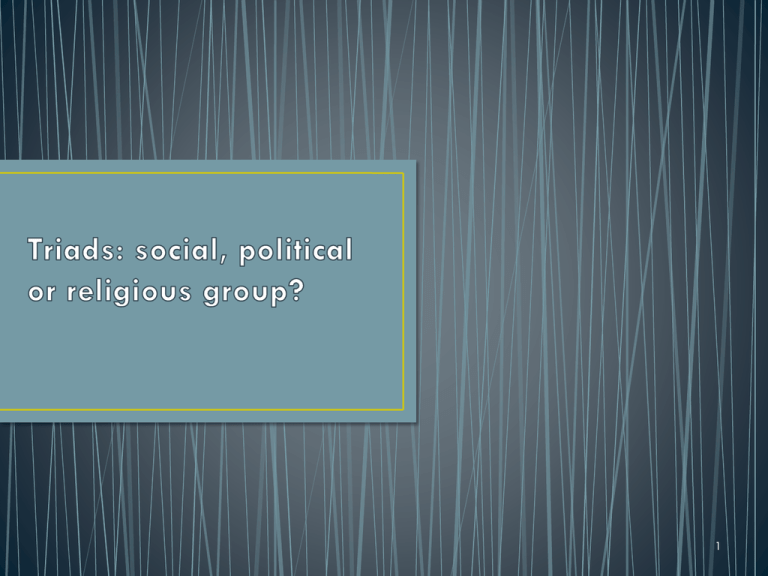
1 • definitions decide what you will find • historically defined group (descending from Coxinga/Ming loyalists/etc.) • type: organized ethnically Chinese crime • group sharing specific rituals and myths (my preference) • historiography • suffers from inconsistent different definitions • has attempted to separate the political and religious • tends to side with state (in definitions of crime) and romanticize Triads • concepts • history vs mythology • social, political and religious 2 • largely in context persecution and repression • Qing state • colonial state • local gazetteers • ritual manuals • from early 19th century onwards • descriptions of ritual • in confessions • (very few) partial eyewitness accounts (Western) • painting of initiation ritual (Singapore) • extant altars (HK and Singapore) • contextualisation within local culture of the south 3 • see also detailed historiographical survey by Dian Murray (Qin, Baoqi coll.), The Origins of the Tiandihui: The Chinese Triads in Legend and History (Stanford: Stanford University Press, 1994) • Western colonial officers stressed ritual and myth, for instance: • • • • Schlegel Ward and Stirling (Freemasons) Stanton Morgan • Chinese academic historiography • inspired by connections to the nationalist revolution (early on, still alive) • linking up to Zheng Chenggong/Ming loyalists • analyzing foundation myth as close to history • looking at movement thru archives and local histories • role as moving force of history (rebellions, revolution) • Triads as mutual support groups, gangs or otherwise (close to Qing readings) • Western academic historiography • early work influenced by marxist models • more recently: following Chinese work stress on mutual support groups 4 5 • categories split and confine • this is necessary, but always analytically subject to correction and replacement • risk of projecting back modern categories (check: our definitions of the political, social and religious) • social and religious often coincide • as a result use of terms such as “diffuse” religion • earlier therefore proposal: all lasting social formations in premodern China have a cult of worship at their centre • Triads are such a group, with a twist: with addition of a seemingly political dimension 6 • sufficient elements of the following characteristics • name (or a variant): Heaven and Earth Earth Gathering 天地會, or Triads 三合會,三點會 • family name Hong 洪 (radical!) • bloodcovenant • initiation ritual in three passages • elements foundation myth • on this basis • selection cases • selection topics for analysis 7 8 9 • frustrations of Qing officials and colonial officers • Triad members unable to “explain” their ritual and mythology • foundation myth or history • what is explanation anyhow? • Triad members: quoting poems from the ritual • us: taking ritual apart to explain its purpose • how do we know our explanation is “true” and what is the relevance of this “explanation” • “true” : by contextualising within rituals and narratives of the participants as a group • relevance: ask and answer the quesiton of how participants in a culture “know” meanings and what “meanings” mean 10 • central devotional act without intrinsic Triad meaning • Triad founders on the run had to use grass • incense burner as ritual centre of a cult group • more important than statues etc. • miraculous appearance of the White Ding burner with the text 復明滅清 • leader initiation ceremony called Incense Master • reenactment by new members of first incense burning by Triad founder creates community in the present and links up with the past 11 • bushel commonly used in variety of rituals (at least since Tang) • measure filled with local grain (=community) • objects (scissors etc.) inside receive Triad specific meanings taken up their exorcist functions • five-coloured flags or threads symbolizing Five Encampments/ Five Houses Triad mythology • Triads: 木楊城 or safe haven • altar • table with incense burner, bushel, candles, sacrificial food • other objects on the altar as location in the City of Willows 12 13 14 • liminal places and transitions • occur all the time in ritual practices & narrative elements • • • • grottoes rivers & bridges gates, passes seas & boats springs, sources, wells • places for administering status • cities for salvation (incl. Western Paradise, imagined as a city) • cities for judgement and rebirth (underworld) • safe places & retreats • gardens • grotto worlds • rituals and narratives manage transitions between different states of being (death, life, no-death, before life, etc.) • funerary ritual • after-birth rituals • exorcisms 15 transitions&connection s enactment journey through hell (funerary ritual) 中元/鬼節 廈門 龍珠殿 送王船 16 death/separation crossings • Tian Youhong’s interview with the gatekeepers • preliminary questions • encounters with two mysterious women • Dark Dragon Hill & the Foot of Nail Mountain • boat crossing of Triad River at Hongying Ferry, landing at Great Peace Market • under the bridge with the two beams 17 passages birth purification incorporation • • • • • • Hong Gate Hall of Loyalty and Righteousness Circle of Heaven and Earth City of Willows Mountain of Fire concluding blood covenant at the Hong/Red Flower Pavilion • festive banquet 18 “竹簍檔太陽,很重要的動作”: more likely a prophylactic measure, traditionally with winnowing basket crossing the fire with possessed sedan chair 19 • ancient and common practice • drinking alcoholic spirits mixed with blood of sacrificial victim (attested since CQ & WS period at least) • gate of swords (attested in Song source!) • aim to strengthen mouth as vehicle of words • self-imprecations • contents covenant • sworn 洪 brothers • duties of family members • self-imprecations 20 membership certificate 21 • contextualisation=> • use conventional practices => meaning ritual works through shared cultural experience • no meaning, but meaningful • made specific by Triad mythological explanations (next section) • Triad internal explanation • as theatrical performance in five acts and an epilogue • First Act: Gathering Together in the Flower Pavilion • Second Act: Instructing the Children in the Central Hall • Third Act: Taking the Oath at the Flower Pavilion • Fourth Act: Meeting at the Side of the Bridge • Fifth Act: Stabilizing the Country and Beheading the Traitor • Epilogue: Banquet • other indications: ritual preface with Eight Immortals, make-up of the Vanguard official in the British Museum Triad manual, use of whip to indicate 22 horse riding (Morgan description) etc. 23 • “narrative” • to explain and justify the Triads>conceived as history • modern view would deny historicity=> mythological account • matter of degree: academic history often serves legitimation attempts! • specific aims of the narrative • creation of an in-group (Triads) and out-group (the Qing state) • justification of Triad activities as legitimate on a higher poltical level • fall-from-grace plot is widespread type of southern Chinese story (more further below) 24 • at the time of Li Zicheng one concubine fled>gave birth to the Young Prince • rebellion Xilu Barbarians(Xilu 西魯~Xifan 西番) rebelled >emperor asked for help • Shaolin monks from Gansu (!) responded> defeated the barbarians, thanked by emperor, returned to monastery • traitorous official persecuted the monks, 13 survivors fled • appearance of incense-burner with 復明滅清, made into focus blood covenant survivors • successful fight against Qing armies • loss Young Ruler and their original leader Master Wan, founding of the Five Houses from the five provinces 25 impact of fiction: Putian ‘s Shaolin Monastery 26 • uniquely Triad elements • High Creek as important location(1787>) • Red Flower Pavilion as important location (1787>) • story of fighter monks, dispatching spirit soldiers, losing their lives with 13 monks left (1787 >) • meeting Zhu prince and Triads (1801-1802>) • mythical date jiayin (1801-1802>) • Zhu-prince flees the imperial palace (1803-1806>) • City of Willows (1803-1806 >) • Triad (Five Houses) armies from specific provinces ((1803-1806>) • Shaolin monastery in Gansu (1807-1808 implicitly, 1810 explicitly >) • Mount Wan (1807-1808>) • first complete narrative extant in 1810 manual, most constituent parts already present several or more years before • names most prominent figures stem, from demonological messianic paradigm (see further on) 27 • examples • • • • Patriarch Luo (Non-Action Teachings foundation myth) Eight Trigrams Green Gangs Yao culture and other southern local cultures (partially) • basic plot • • • • loyal service to the imperial state in defeating barbarian ennemy reward betrayal strong in-group consciousness 28 29 • similar to tradition of charismatic networks discussed in an earlier lecture • cosmic change and the fall of the dynasty • preceded by violent times filled with war and the coming of the apocalypse (often mention of a Black Wind) • advent of divine armies from distant places, led by a young ruler and his generals, to defeat the demonic creatures causing apocalyptic disasters • western location as origin saviour • find of treasures, city as safe haven • no role for the Eternal Venerable Mother myth • in late imperial period mainly a southern paradigm • Qing version: • prince is of Ming Zhu-family descent • generals have auspicious names suggesting long life 紅, 桃, vastness 洪 and auspicious numbers 九, 萬. • some cases • Ma Chaozhu (1752) and other smalls cases • crucial impact on Heavenly Kingdom of Great Peace (in notion safe haven in Nanjing, barbarian./Manchu threat) 30 五營~五房 31 • Young Prince (Young Prince important folkloric element in general), referred to as 明君, 明王, 明主 • general as assistants with auspicious names 朱洪德, 朱紅竹, 朱 九桃, 李桃洪, 朱七桂 ,萬雲龍 and so on • demological armies from concrete distant places 五房 • city as safe haven (City of Willows 木楊城), compare 楊州/陽 州 • Sichuan (western location) as provenance savior • fixed date (jiayin 甲寅) • weak sense of apocalyptic disasters, but strong sense of barbarian (Manchu) threat 32 • weak messianic impulse • messianic ruler present: Young Ming Prince • concrete event in the future predicted, not expected • weak sense apocalyptic disasters • possible moments • translation into activities against Manchu/Qing regime • maybe during the Triad uprisings of 1840s? • maybe some expectations in late 19th century =-> collaboration early nationalists • for an evaluation, discussion of political symbols is required 33 34 • Mandate of Heaven • Son-of-Heaven as recipient of tribute (i.e. not ruler over territory): ordering All-under-Heaven • classical and vernacular Daoist ritual specialists: ordering All-under-Heaven • local deities with feudal titles: ordering the local territory on behalf of heaven • shared language • • • • • “following [the mandate of] heaven” 順天 “the revolution” 運 seals precious objects (tripod, sword, etc.) messages from heaven • please note: • political and religious dimensions coincide • here: political and messianic dimensions coincide • treasures also have exorcist functions 35 • leaders of Triad events who were never arrested: • • • • Wan Tiqi 萬提起 (1787 Lin Shuangwen rebellion) Zhu Jiutao 朱九桃 (1851intended [?] uprising) Zhu Hongying 朱洪英, Zhu Shenghong 朱盛洪 a.o. (1852 actual rebellion) Wan Dahong 萬大洪 (1850s Guangdong Red Turban rebellions) • extensive search, at best claimed death=> mythical elements confused with real history • political or religious rebellions? • probably both • attempts to bring the ideal Triad state about • low level of long term planning • some late 19th century Triad leaders may have seen nationalist revolutionaries in similar light 36 37 • as part of nationalist historiography=> creating a pedigree/historical depth for nationalist activities • Ming-loyalists (not entirely untrue, although always a myth) • anti-Manchu • connecting to Zheng Chenggong/Koxinga • martial arts connection • Shaolin element • prelude of martial arts films • Incorporation into martial arts foundation myths, historical depth unclear • proto-revolutionaries • because of purported nationalist connection • social rebels (mutual support groups) • police exaggeration • organized crime> more funds & more freedom of persecution 38


